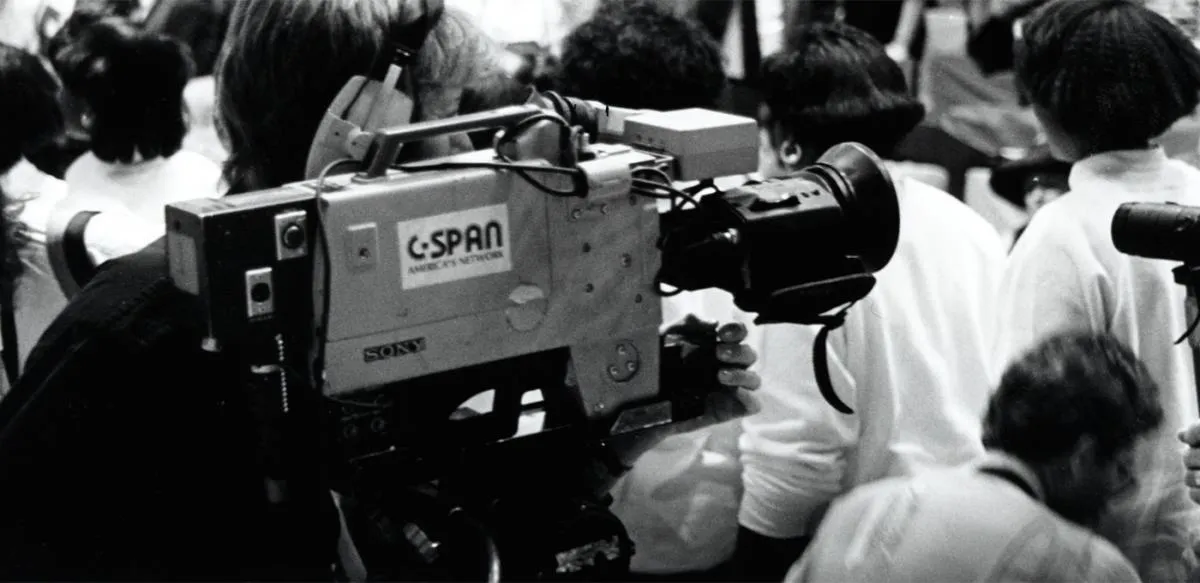In the early 80s, after visiting the White House, a group of high school students were touring a new TV network called C-SPAN, where they were attending a live broadcast of a call-in show. When the host (C-SPAN Founder, Brian Lamb) answered the phone on air, he was told to hold for the President of the United States. Sure enough, then President Ronald Reagan was on the other end of the phone, praising the students for their engagement in the civic process after he tuned into C-SPAN from the White House’s private residence and recognized the group from earlier that morning.
C-SPAN is more than a network—it is a mission. From its launch in 1979 to today, the network has stood out among its peers for the unique way it operates and approaches news coverage. But the C-SPAN success story we know today wasn’t guaranteed, it was built by hardworking people committed to the idea that Americans deserve an unfiltered view of the day-to-day work of governing. Few people understand that journey better than former C-SPAN VP of Finance Jana Fay, who just retired from the network after 42 years of service and shared her insights and favorite moments (surprise Presidential call among them).
Fay started her career here at NCTA, her first entrée into the then-emerging cable TV industry. Within a year, she found herself on the ground floor of the brand-new network. “Brian [Lamb] was looking for someone to help start up [the network] so within a year [of starting at NCTA] I went and started at C-SPAN six months before we went on air.” Fay would be the first person Brian Lamb hired, earning her the nickname “Number One” at the network where she would continue to work until her retirement this summer.
With a mission and a hope, C-SPAN launched in 1979 and would broadcast from 9 am to 6 pm for the first few years (the network wouldn’t begin full-time coverage until 1982). Those early days were critical to prove the viability of this civic experiment. One hurdle, Fay explained, was the limited channel capacity in those days, since C-SPAN’s content isn’t guided by audience ratings there was competition with other networks for channel space. “We were just this nice little public affairs network. And the challenges were really for people to understand the value of it, but I think the viewers saw it right on.”
Besides being VP of Finance, Fay also served as corporate secretary to the C-SPAN Board of Directors during her tenure, witnessing key moments in network history. One of her final projects involved going back through her meeting notes. “I read through 42 years of history and I’m going ‘oh my god!’ There’s just so much richness there – in terms of the impact the cable operators had financially and from a carriage standpoint, and the viewers who were just eager to have this kind of public affairs information.” The C-SPAN Board is made up of committed industry leaders, and over the years 149 different people have served on that Board. By her own count, Fay took the minutes for 57 Board meetings and 55 Executive Committee meetings over the years, and one theme that stood out was how important early strategic support was for the network.
Leaders in the cable industry quickly saw the value in C-SPAN, committing to fund the network to ensure its mission would remain the guiding principle. The new network found early champions in people like Amos Hostetter (Continental Cablevision), John Evans (Evans Communication), Bob Miron (Advance/Newhouse), Ed Allen (Western Communications), Bob Rosencrans (UA-Columbia Cablevision), and many more who were committed to the network’s success. “The board has played an incredible role in terms of how we proceeded from a business standpoint,” Fay explained. It was critical from the start that C-SPAN be guided by public value, not by influence from politicians or any other interests.
“I think the reason we’ve been successful is because number one we’ve stayed true to our mission,” Fay noted. Because ratings do not translate to financial success for C-SPAN, they are able to take a much different approach than traditional networks when it comes to deciding what and how to cover an event. The recent party conventions, for instance, are broadcast from start to finish with no commentary or interruption, compared to ad-supported outlets that have to balance competing networks as part of their editorial decisions. As a result, viewers know when they turn on C-SPAN, they get the full picture as if they were there themselves. “We’re in it to show a public service. You can always tune to C-SPAN and see the live event.”
When she looks to the future, Fay says she’s optimistic. She points to the continued support from industry leaders like Pat Esser (Cox Communication) and Dave Watson (Comcast). “I think there’s a very definitive role that C-SPAN plays and I see it through the coverage that we’ve just done with the RNC and DNC, anything that we’ve covered that’s big, we’re there all the time covering it, and that’s our mission…42 years later, we’re living our mission, we’re trying to look upon new technology and ways to provide our content in a way that helps. ”









